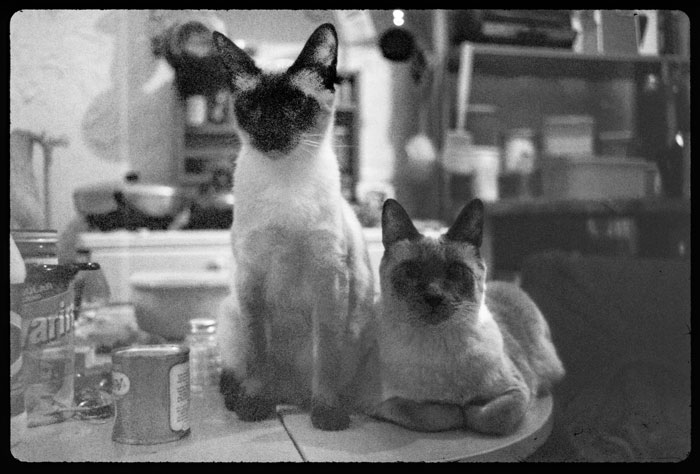

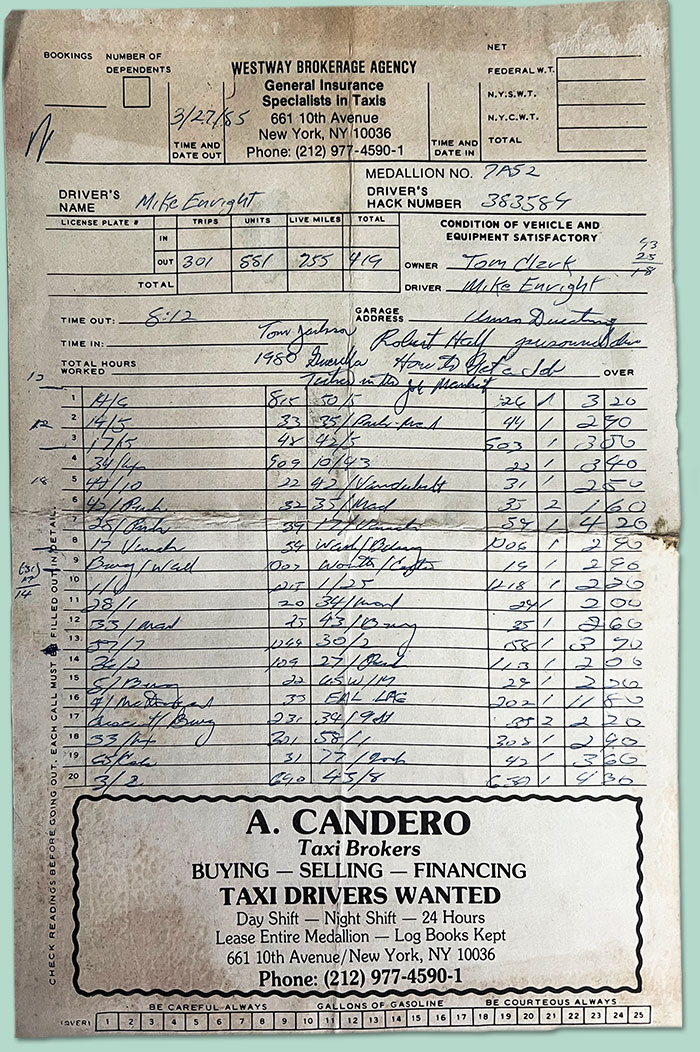
A trip sheet
The trip sheet was the foundational document for a day of work on the streets. It told who owned the cab, who the driver was, when the driver clocked in and clocked out, and all the trips the driver chose to record: from, to, and the fare. Perhaps it will be interesting to future historians of the industry, or to no one at all, ever.
At this point I drove for a driver who owned his own medallion (the license to drive one taxi in NYC). He mortgaged his ass to buy it; the value of these things grew higher every year. Before Uber finally shoveled the dirt on the graves of all medallion owners in New York, these plastic shields (secured with bolts to the cab) had grown so valuable that they became investment devices for lawyers, doctors, and anyone else interested in making a buck. By the turn of the century no driver could afford them without a high-risk loan. After Uber a driver-owner paying off the mortgage was a suicide risk.
Looking closely at this particular sheet reveals a lot about my habits. I hated the day shift, for one thing. All traffic, all day; night trips were longer and tips were better when people were out having fun. Starting at 8:15 AM was at least two hours later than when I should have started. To this day I don’t do well at early rising. There’s a huge gap between 4 PM and around 7:00; I was probably running errands or having a nice expansive lunch at Katz’s. I don’t know why Tom (the driver-owner) was letting me keep the cab out so late; I usually parked it in one of our usual spots no later than 6.
I also see that I’m using the sheets to make notes; I was probably getting some advice from a customer about getting out of the business. I see book titles: How To Get a Job, Guerrilla Tactics for the Job Market. I wasn’t driving for much longer.
Any good cabbie would have seen this trip sheet as evidence I was lazy. That’s what I thought, too, until my shrink told me that there was no such thing as lazy. There are only degrees of resistance.
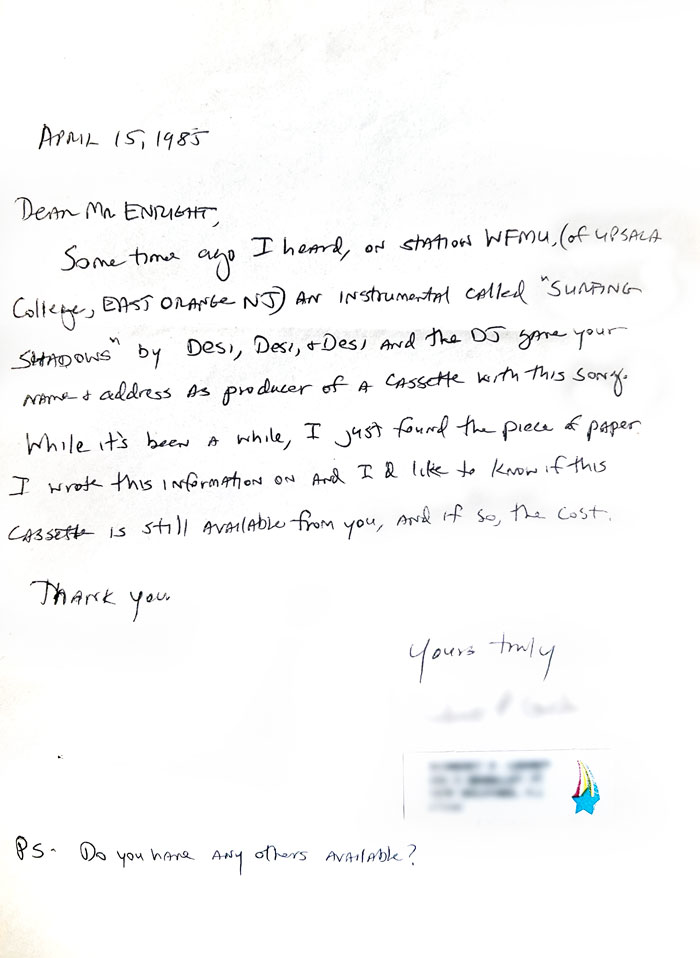
An inquiry for the band
At some point earlier in the year we'd gotten a bit of airplay for the Desi cassette on WFMU, the New Jersey-based free-form radio station heard through most of NYC. I know they played our surf instrumental "Surfin’ Shadow" and our depressed ballad about the East Village, "Avenue A." Not long after I received this letter from a surf music fan in Jersey.
Six months later I got around to sending him a copy of the cassette. This was typical of my cavalier marketing approach; obviously I was waiting for the record company to do this sort of thing. Note also the obsequious tone and my recounting of the disaster which was my career in the band business. I’m also sure we played out more than once in 1985, though the end was certainly near.
Then three weeks later the ignominy of the reply: he still liked the surf tune but the rest was "too weird," in particular "the really awful version" of "Telstar," a song that had been a real labor of love for me. I was humiliated; I'm also not sure he returned the cassette.
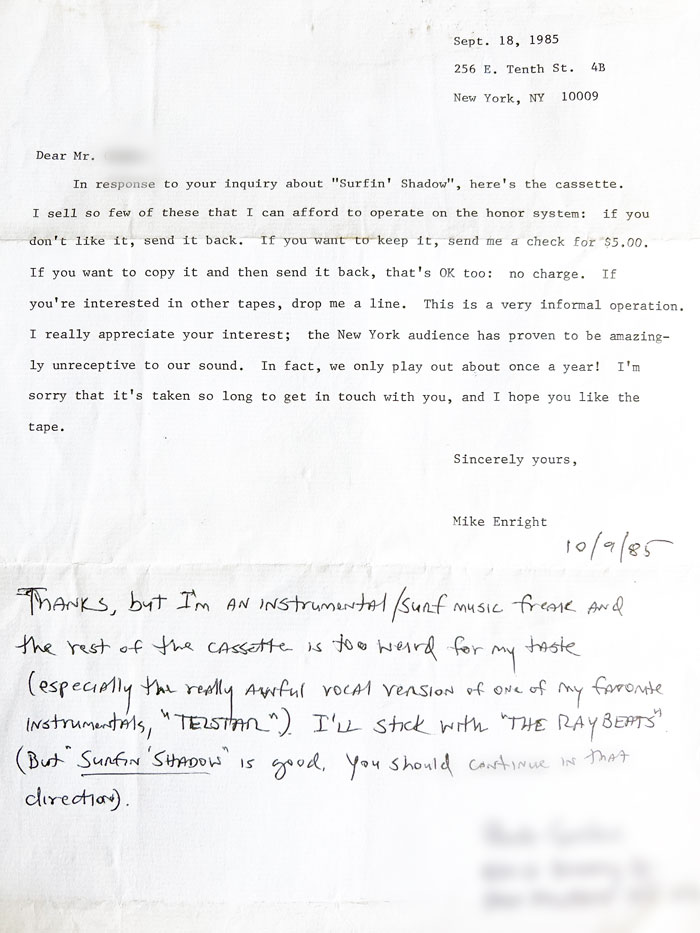
My feelings around ninety percent of the time? I've spent my life making inconsequential things for disinterested people. I exit without a ripple; the moment the hosting service doesn't get paid everything I've placed here will disappear. In 1985 I would assuage existential doubts with bourbon or a drug. I don't drink anymore—I fall over—but I still have the same doubts about everything (including this project). Why am I still doing it? For christ's sake, I'm seventy years old.
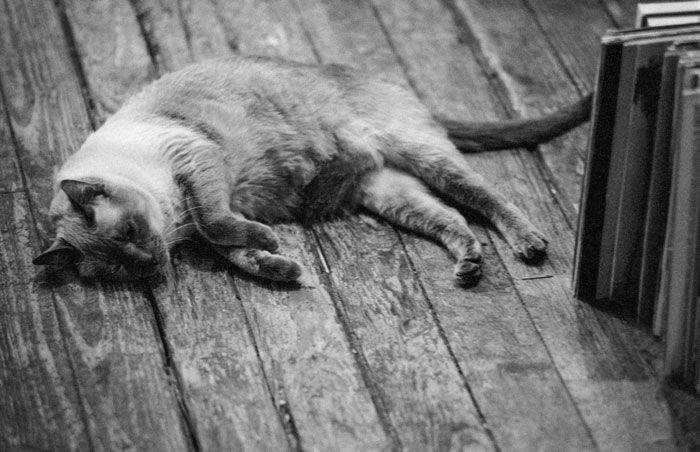
EV life: floor with holes, cat, LPs
The older Siamese, Punque, is seen on our living-room floor in the picture above. In the picture below is the younger, Black Carl, hiding behind the radiator, which after the first cold snap never went off. Temperature could not be adjusted, true in many New York apartments but especially for those in the poorly and quickly built tenements of the Lower East Side. Our apartment was so hot the windows were open for the entire winter.
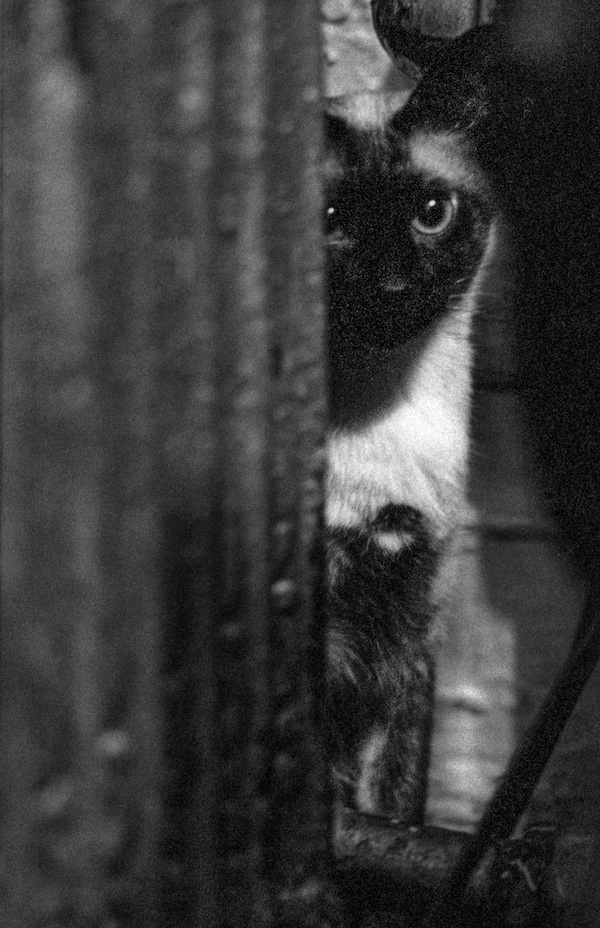
Carl was a late addition to our lives; the older Siamese (Punque) had been with Fran since before I knew her. I think Carl joined us before we moved from our Cincinnati loft in 1979. The two of them unhappily travelled with Fran when she made her journey back to Ohio. I haven't had a Siamese since and I miss their beauty and sense of aesthetics: they always manage to plop themselves down in the center of gorgeous compositions of shape and color.
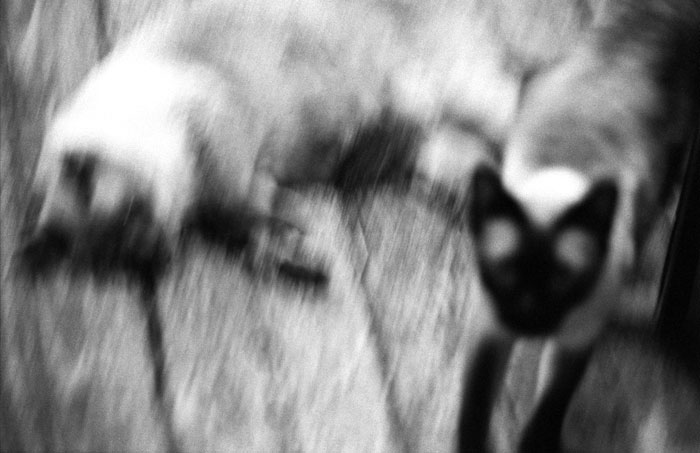
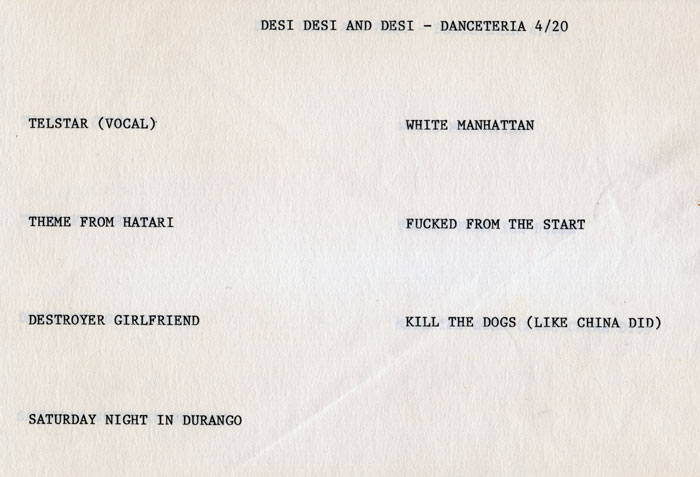
Set list for the last gig
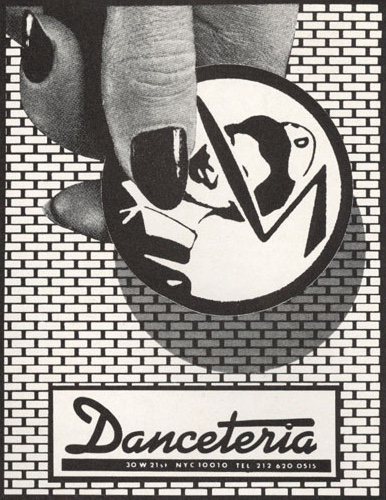 Congo Bill's was the fourth floor of a popular nightclub called Danceteria, what was advertised as a "club within a club." I have no idea how we got the gig, though I suspect Bonton Eric was involved. Was it a prestigious gig for us?
Maybe. I had some simmering ambition but no idea how to make it work for me.
Congo Bill's was the fourth floor of a popular nightclub called Danceteria, what was advertised as a "club within a club." I have no idea how we got the gig, though I suspect Bonton Eric was involved. Was it a prestigious gig for us?
Maybe. I had some simmering ambition but no idea how to make it work for me.
We had an expanded lineup at the Congo Bill's gig that included Dennis DeMeo on pedal steel (especially useful for the country tune "Saturday Night in Durango") and Eric Darton from Bonton on an early Korg synthesizer. We needed a keyboard to play harmony on the hook in "White Manhattan." Both of them played on other numbers as well, probably with little rehearsal.
"Telstar" featured a duo vocal with Fran and I; "Theme from Hatari" was my arrangement of the Henry Mancini tune from the Howard Hawks movie. (It was one of the many hits on the first LP I ever purchased, The Best of Mancini.) "Fucked From the Start" was a twelve-bar blues that I didn't figure out how to sing until years later. "Destroyer Girlfriend" was a straight-ahead groove, a bass riff occasionally doubled with guitar; I rapped or chanted or spoke rhythmically on top of the groove. It wasn't hip-hop though that was certainly in the air in those days; for me it came straight out of the patter songs from The Music Man, though Meredith Wilson would have been appalled at the explicit sexuality. Both "White Manhattan" and "Kill the Dogs" took the same approach. I played what Arto Lindsey of the no-wave band DNA called "skronk guitar" on top of all three. "Dogs" and "Destroyer" had been in the set list since the very beginning, and the former was our usual closing number. The whole set was probably about a half-hour long, then bye-bye Desi.
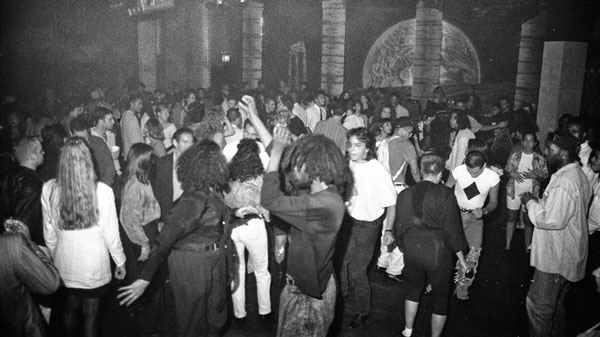
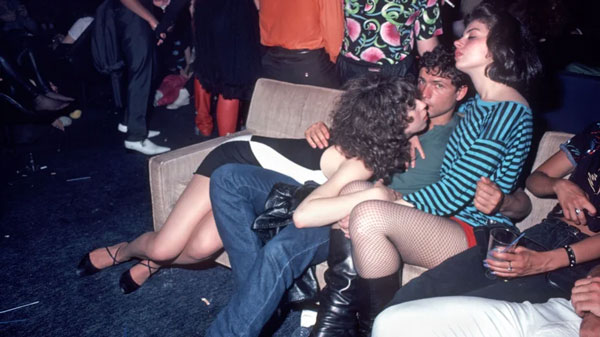
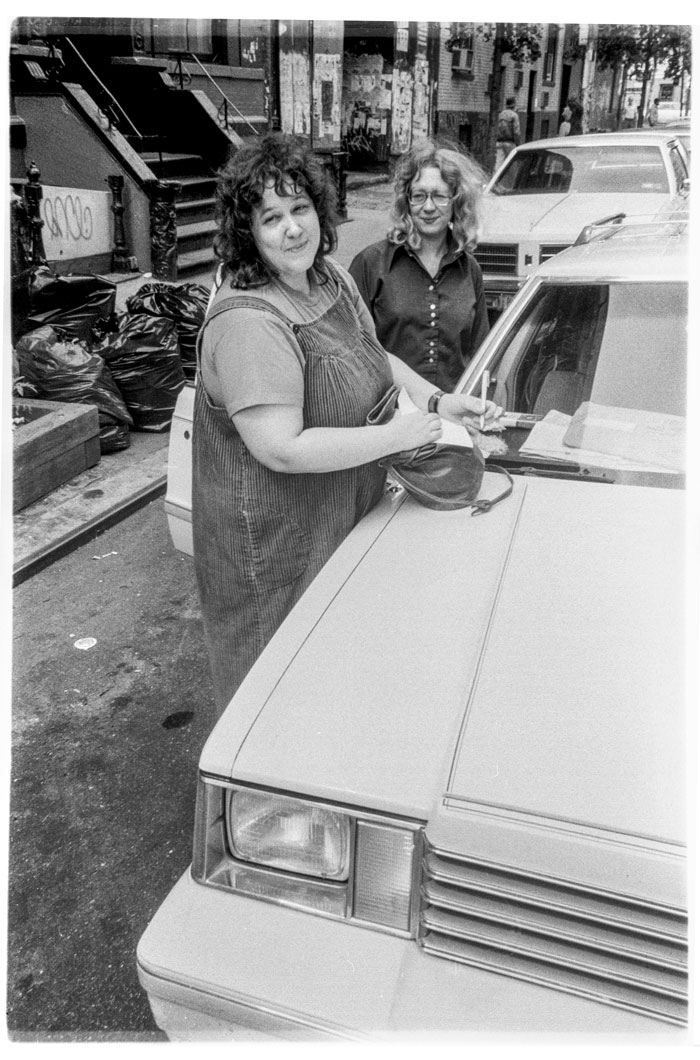
Fran leaves New York with sister Kate riding shotgun
Fran with her sister Kate starting the move back to Cincinnati. She missed her family. Fran thought that I would eventually return to Ohio and that we would resume living together, though I told her many times I would never go back. I had asked her to marry me during an emotional fugue in the hours after my grandfather's death; I assumed that was all over when she left but I'm not sure she thought the same. We never talked about it again. As Catholics from the midwest reticent to discuss anything that would hurt, there was a lot we never talked about.
Though we didn't know it at the time, the Desis had played their last gig a month or two earlier. Below is a Desi tune written for Fran.
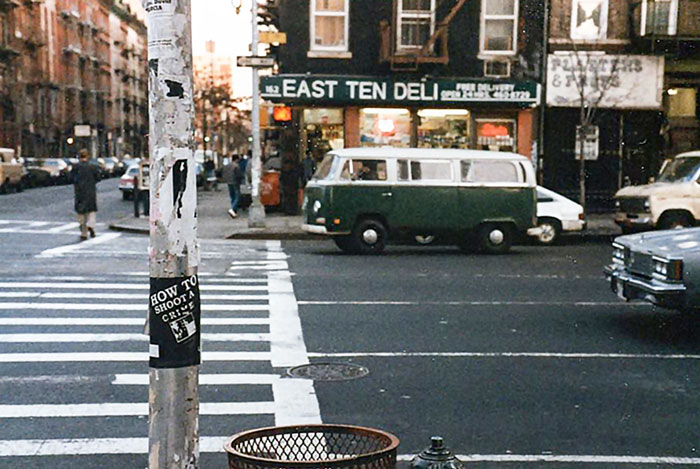
My corner, First Avenue and 10th Street, in 1985. Photographer unknown.
My corner, First and 10, with my deli in the background. Two Lebanese brothers operated the business. I loaned one of them $40 before realizing he'd become a crackhead. In 1991 I used the deli as a location for a brief scene in the video The Look of Love.
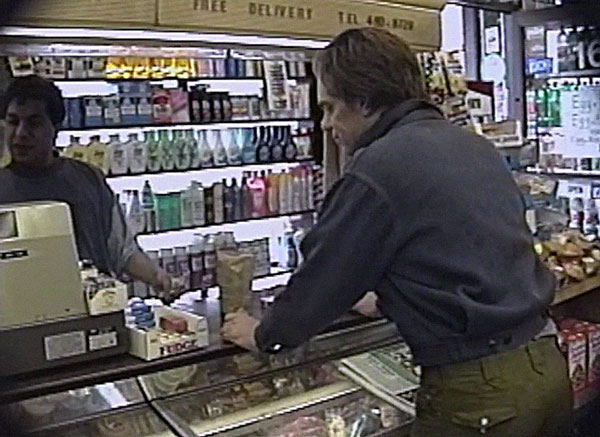
By the mid-eighties the corner swarmed with teenagers selling pot (or depending on who you met, carpet fibers). Later in the decade, after I'd begun to teach at JHS 60 around the corner, I recognized some of them as current or former students. "Yo, Mr. Enright!" I'd hear as I pushed through the crowd. I never felt safer in my neighborhood.
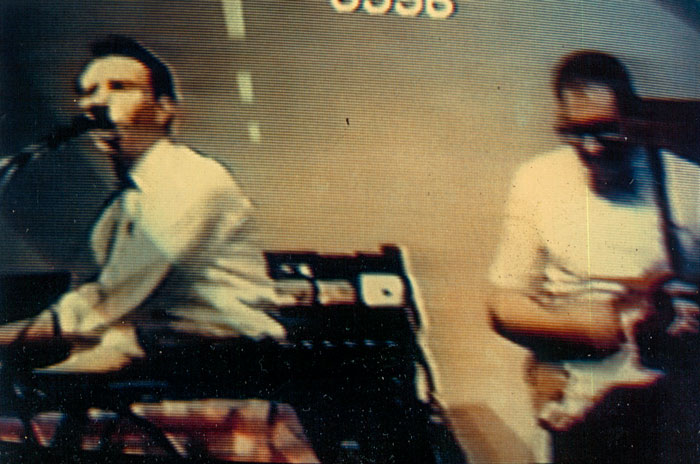
Eric and I at Bonton gig, NYC. Photographer unknown.
Eric Darton was a writer for the East Village Eye and a conceptual artist who put together a band called Salon Bonton. Half the time we played at art spaces, the other half at clubs. We would play one of Eric's tunes, then stand aside while he did some art, then play some more music. Unfortunately the stop-start nature of the performances prevented us from getting much of a groove on. I did like the material and the art was interesting, often transgressive and political. Eric was great at promotion and got gigs at The Mudd Club, 8BC, No Say No, White Columns, ABC No Rio, the Pyramid Club, Danceteria, and many others. I remember loading equipment into some club while the huge sound system was pumping out Shannon's hit “Let the Music Play.” I knew it from boom-boxes on the sidewalks and car radios on the streets; it was transformed into something wonderful at club volume.
I'd been involved with Eric since my very first months in New York; I don't remember how we met. He was living in the Chelsea Hotel at the time. Even before I formed my own band (Desi, Desi, and Desi) I played an early gig at Tier Three with Cult de Ghouls, a group he put together with his ex, Carola von Hoffmanstahl, and her new boyfriend David. I got the 10th Street railroad flat where I lived for seventeen years through David.
Carola was a striking woman, tall with really short hair, a buzz-cut without the basic-training vibes. She lived in Eric's old flat in the West Village where one bathed in a stainless-steel tub, there being no bath. There was a New Year's Eve at the Chelsea where we stood on a balcony together while Carola chucked empty champagne bottles onto 23rd Street. There was a tune called "Etan Patz" that became the only Cult de Ghouls 45; while she performed it I became acutely aware of just how tasteless and cruel it was. I was too much of an Ohio boy to ever feel comfortable with the material.
Salon Bonton was another story, though, and Eric's tunes were good. They called for a much lighter touch than I was used to with the Desis and I enjoyed it. Mike, the Desi's young drummer, also played with Bonton, as did bassist Fran and guitarist Byron, though membership shifted from gig to gig. Eric's wife Katie was always there on the clarinet, as was Paul Shetler on vocals (and I don't mean singing).
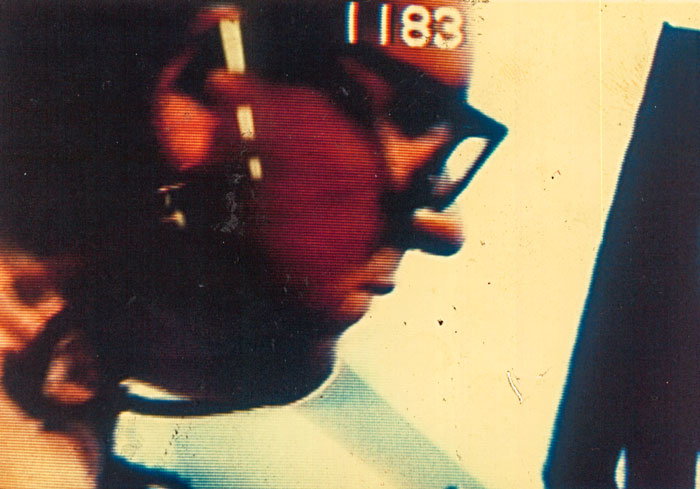
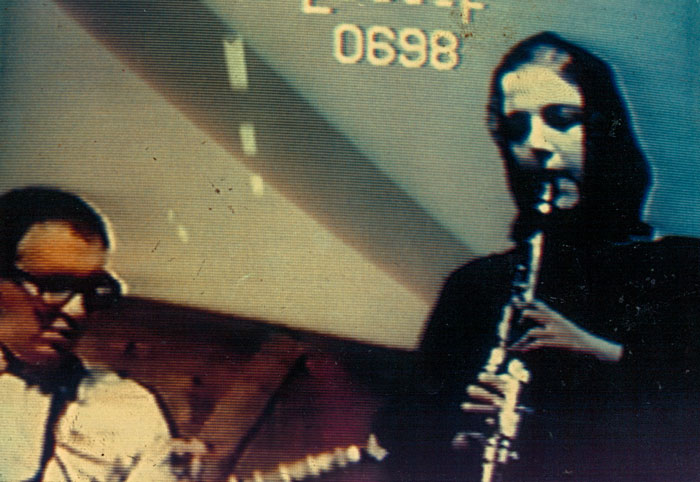
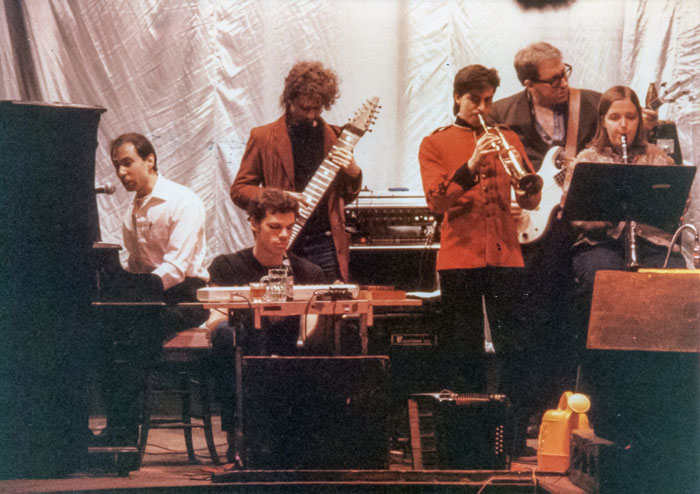
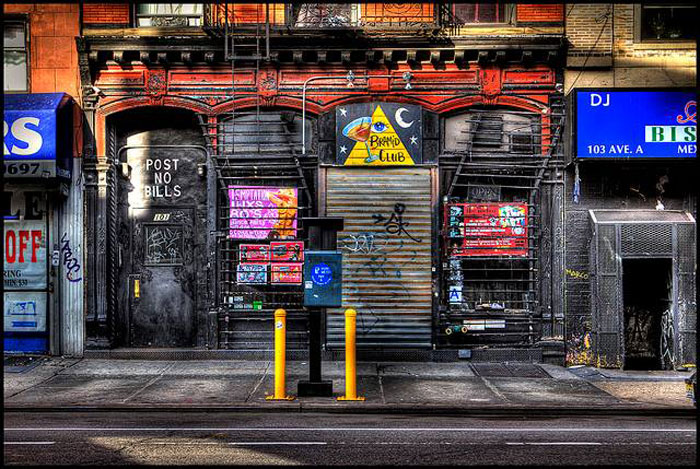
The Pyramid was a club just across the street from the A7 that featured a lot of alternative theatre and drag performances. A troupe that acted out sucessive episodes of The Brady Bunch found its home there. Wigstock, the annual drag celebration at Tompkins Square Park, became a reality when a drunk Lady Bunny and other performers from the Pyramid slipped outside for an outdoor show.
I remember nothing of our set. This club was just the kind of art/performance space where Bonton did well and the Desis wouldn't have gotten past the door.
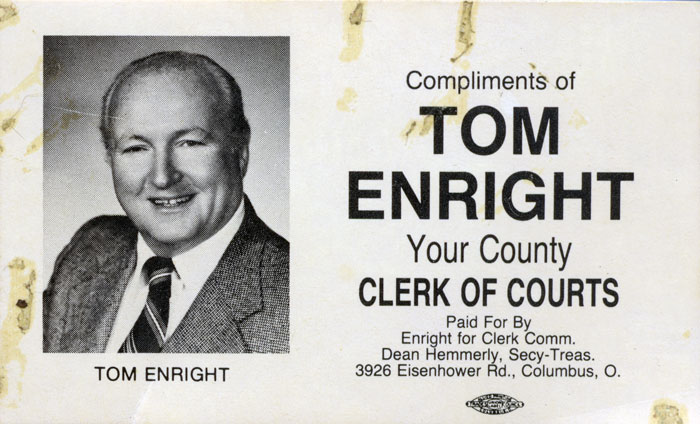
Tom Enright's 1985 OSU football schedule
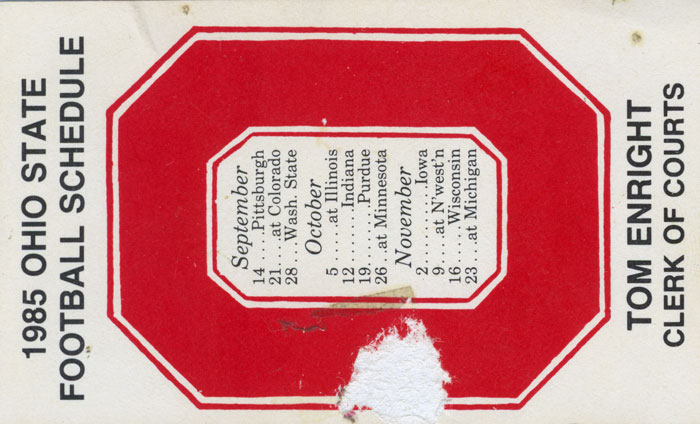
I have no idea what happened to Ohio State that year. The intense focus on football in Columbus brought out my most extreme contrarian impulses. My high-school was also an Ohio football powerhouse, and my AP English instructor was the football coach. He'd been assigned our class because we were going to read the books anyway and were not going to give him any trouble. Football was God; this was true even at the end of 60s when hippie culture was at its most fashionable—fashionable everywhere except in my high-school.
Some of the jocks were nice guys and weren't, as we said in those days, "straight" (not a sexual reference but a sneer towards those who didn't use drugs). Later I lived with a very nice guy who'd been our high-school quarterback. His girlfriend, herself a former cheerleader, lived with us as well in an older three-story near the OSU campus. I liked them; they knew what was going on culturally and they were fun to hang out with. The quarterback played for a season or two at OSU, then was sidelined with an injury. Famous coach Woody Hayes didn't think the guy was that injured and dropped him from the team without hesitation. I think Hayes might have seen him as a cultural enemy, too. There was a lot of tension about that in the early 70s.
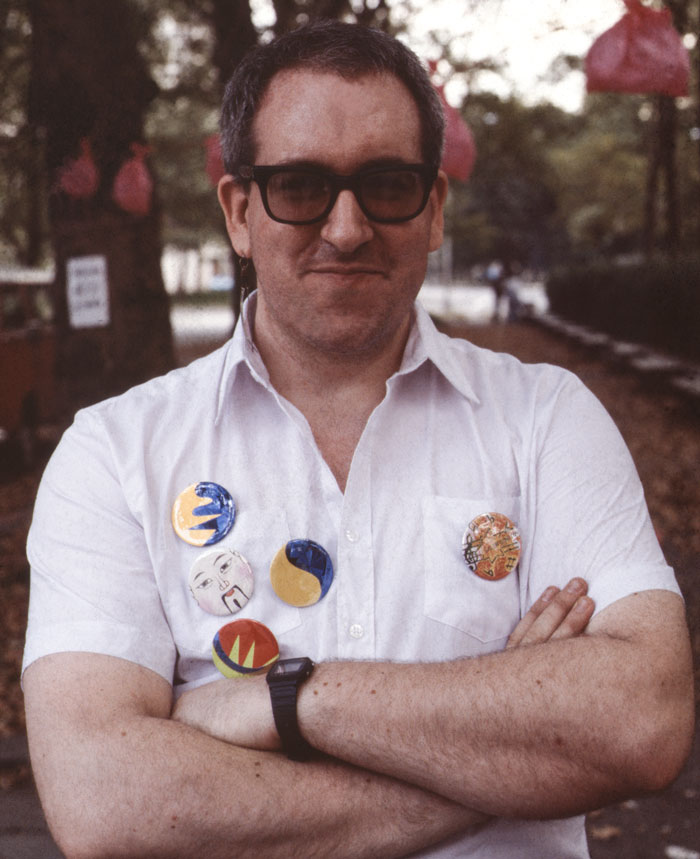
With Salon Bonton at Music for Hot Sundays. Photographer unknown.
Taken after a performance with Salon Bonton at one of the many Music for Hot Sundays shows which went on all summer in various NYC parks. Eric Darton managed to get city sponsorship and the Times published his press release; he had a genius for organization and promotion. I was intensely uncomfortable at these performances; I was never a good enough musician to improvise for several hours and the contributions we got from audience members who brought instruments were usually not very interesting.
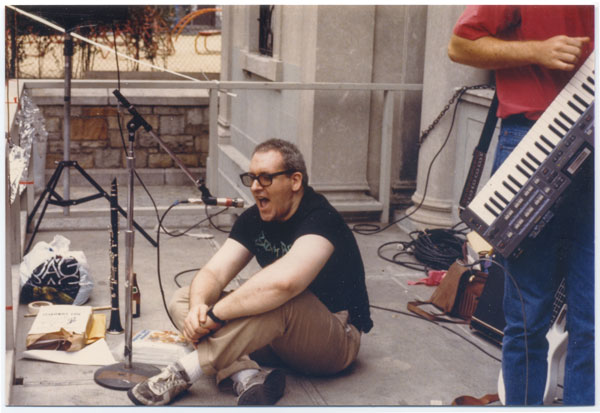
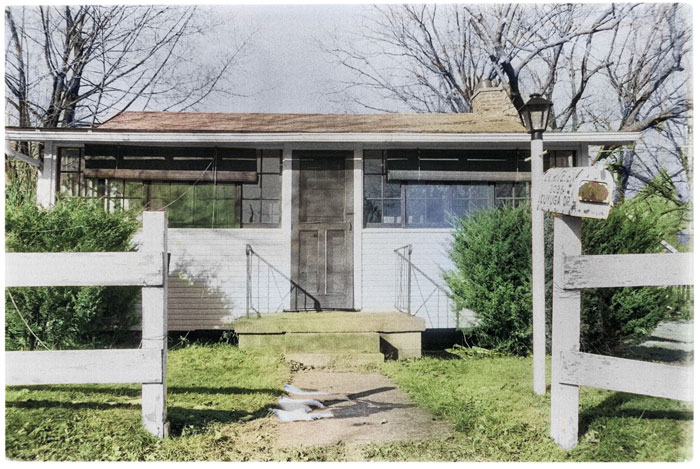
Visting my grandfather's cottage on Xmas trip (tinted to memory)
Many wonderful memories of this place, which in the 50s and 60s was rural. It was right across the river from the zoo; at night going to sleep I could hear the animals making sounds out of the Tarzan movies I watched on Sunday mornings. There were many excellent trees to climb. Later it became a place where we teenagers could hang out, with all that implies.
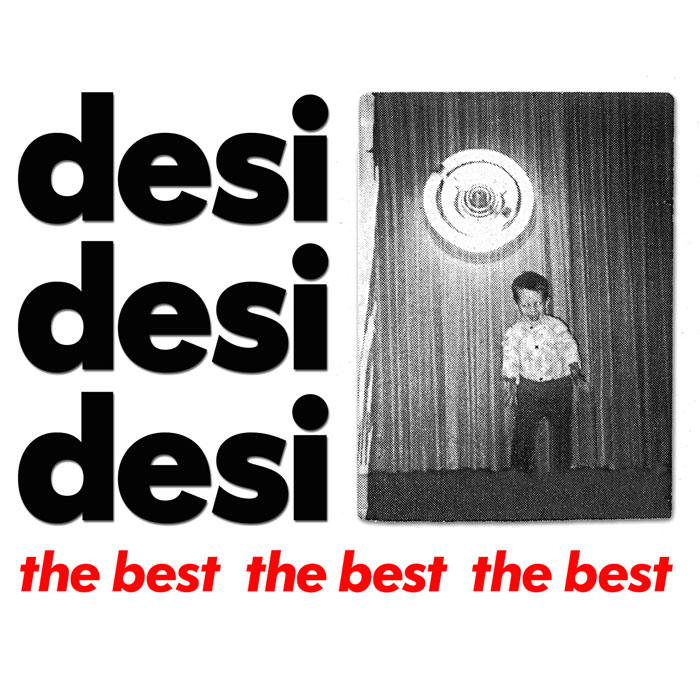
The greatest hits, collected and never released
I assembled many versions of this collection over the years, but nothing was ever made public except that small-issue cassette. I don't know why we didn't promote ourselves more. Fran was working some shit office job and both Mike and I were driving cabs at night. I was drinking a lot and doing any other drugs that came my way. By ‘85 Byron was doing even more drugs than me; it finally led him right out of the band.
There were wonderful nights, of course. People do dope cause it’s fun, or at least because it makes you stop feeling bad. I was in a more or less permanent depression, and it was difficult for me to take anything I'd written or recorded seriously. Life was shit, I was shit. There was a difference in temperament between me and what was going on in NYC, and the Desis never built the entirely accidental following Ed Davis had in Cincinnati. I was thirty-two years old.




